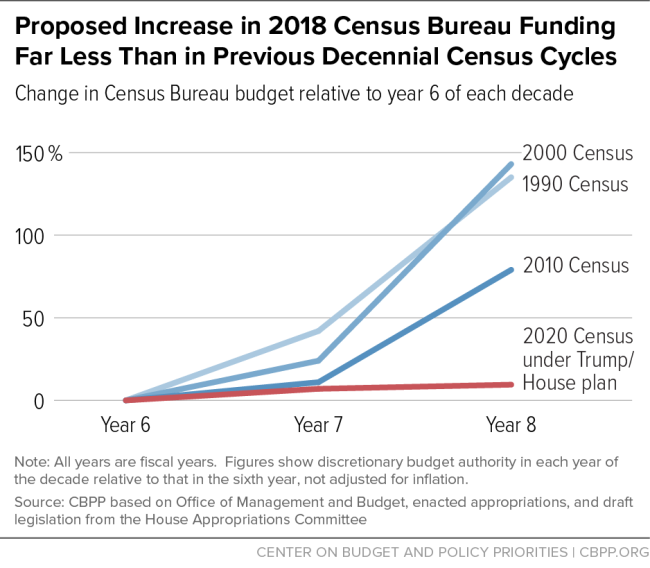Funding Shortfall Threatens 2020 Census
Data is key to government policies, census already behind due to inadequate funds.
“The Census,” said Secretary of Commerce Wilbur Ross, “is the bedrock upon which we construct our system of representative democracy. It provides for apportionment, redistricting, and the distribution of hundreds of billions of dollars of federal funding.”
By this time in the decennial cycle over the last five decades, funding would be ramping up so the U.S. Census Bureau could scale up its activity appropriately to undertake the constitutionally-required enumeration of the U.S. population scheduled for 2020. Yet the Congress has underfunded the Bureau for the last several years, and estimates for a shortfall for 2018 alone now range between $200 and $300 million. Compared to past censuses, the lack of funding at this point in the cycle is striking.
In his October testimony, Secretary Ross indicated that $187 million was “urgently needed” to keep programs on track for the 2020 Census. Scores of organizations across the political spectrum agree with Secretary Ross, including the American Enterprise Institute and the Center on Budget and Policy Priorities, who sent a joint letter to the chairs of the Senate Committee on Appropriations. As the AEI and CBPP put it:
“No policy or philosophical outlook is well-served by a lack of accurate data. The alternative to accurate, detailed data on American households is policy-by-anecdote, in which lawmakers respond to perceived needs without data needed to determine how large or widespread a problem might be, where its impacts are most concentrated, and how it may be best addressed. Such a process would spend federal funds neither effectively nor wisely.”
The impact of underfunding on the Bureau’s preparation for the 2020 Census has been significant. Field tests for more sophisticated data collection in rural areas of West Virginia and on reservations have been cancelled. Development of the advertising campaign that is critical to ensure participation in the census has been curtailed. Some of the modernization plans for address collection and field methods have been deferred. The result? More people will be needed to collect information, ultimately at a higher cost, and the sophisticated technologies that the Bureau had hoped to use in 2020, designed to help reach less accessible groups, will be shelved.
As The Census Project points out, inadequate funding for the census has the biggest effects for “historically hard-to-enumerate populations, including low-income households, people of color, immigrants, and young children,” and rural and remote communities are “particularly at risk” because many of the newer technologies the Bureau had hoped to use in 2020 were designed for the less accessible groups.
Why does underfunding matter? Because a complete and accurate accounting of the population of the United States, and who lives where, is fundamental to the success of the democratic enterprise and to economic enterprise. Census data are used in a multitude of ways beyond merely counting the population:
- To enable a fair allocation of more than $600 billion of federal funds annually, including highway funding, Medicaid, homeland security, veterans’ services, Head Start, and dozens of other services;
- To allocate the 435 members of the House of Representatives among the states and to apportion the congressional districts within the states;
- To establish boundaries for local governmental and school districts, and for local emergency planning;
- To facilitate civil rights monitoring, through compilation of data about race and ethnicity;
- To give state and local governments reliable data to trace developments in and to make decisions about housing, transportation, education, and economic development;
- To enable private industry to make decisions about commercial real estate development and business locations and track migration of sub-populations; and
- To document the diversity of the nation, identifying our majorities and minorities, ethnicities, those with disabilities, age distribution, income distribution, housing information, education, employment, and nearly every other demographic indicator.
Wisconsin, like every other state, relies on accurate federal statistical information – the information that will be gathered in the 2020 census. We have pockets of internet isolation, more than 20,000 homeless individuals, and some highly-mobile low income people among the population, many of whom are children.
A failure to conduct the modernized, fully-funded census could harm some of our most vulnerable populations:
- The huge proportion of Wisconsin’s children of color who do not live in economically stable homes;
- The members of the eleven indigenous tribes or bands, many of which have reservations in remote areas of Wisconsin;
- Veterans reliant on the VA for medical services and hospitals;
- The most impoverished among us, both within cities and in rural areas.
Additionally, the fully-funded census will provide Wisconsin with the best information possible about how to allocate the state’s limited resources.
As former Census Bureau director John Thompson said in the Daniel Burnham Forum on Smart Cities, Federal Data, and Civic Innovation, accessible high quality public data help businesses and communities grow the economy, create jobs, address socio-economic issues, improve the quality of life, and offer better services. Why would we want anything else?
Wisconsin Budget
-
Charting The Racial Disparities In State’s Prisons
 Nov 28th, 2021 by Tamarine Cornelius
Nov 28th, 2021 by Tamarine Cornelius
-
State’s $1 Billion Tax Cut Leaves Out 49% of Taxpayers
 Sep 21st, 2021 by Tamarine Cornelius
Sep 21st, 2021 by Tamarine Cornelius
-
TANF Program Serves a Fraction of Poor Families
 Aug 30th, 2021 by Jon Peacock
Aug 30th, 2021 by Jon Peacock





















